10 Best Reverse Pec Deck Fly Alternatives (No Machine Needed)
Engaging your posterior deltoids, rhomboids, and trapezius, the Reverse Pec Deck Fly is a great exercise for its ability to target the upper back and shoulder muscles, providing work to an area that is often overlooked.
However, not all of us have access to the specialized machine needed for this particular movement. Whether you’re working out at home, traveling, or your local gym lacks a pec deck machine, it’s essential to know some of the alternative exercises that can give you similar results.
In this article, I will provide you with a range of effective alternatives to the Reverse Pec Deck Fly, focusing on movements that target the same muscle groups and offer comparable benefits.
Reverse Pec Deck Fly Alternatives
From exercises with resistance bands and dumbbells to bodyweight movements, my goal is to offer as much variety as possible so, hopefully, at least one of these alternatives is exactly what you’re looking for.
Rear Delt Raises
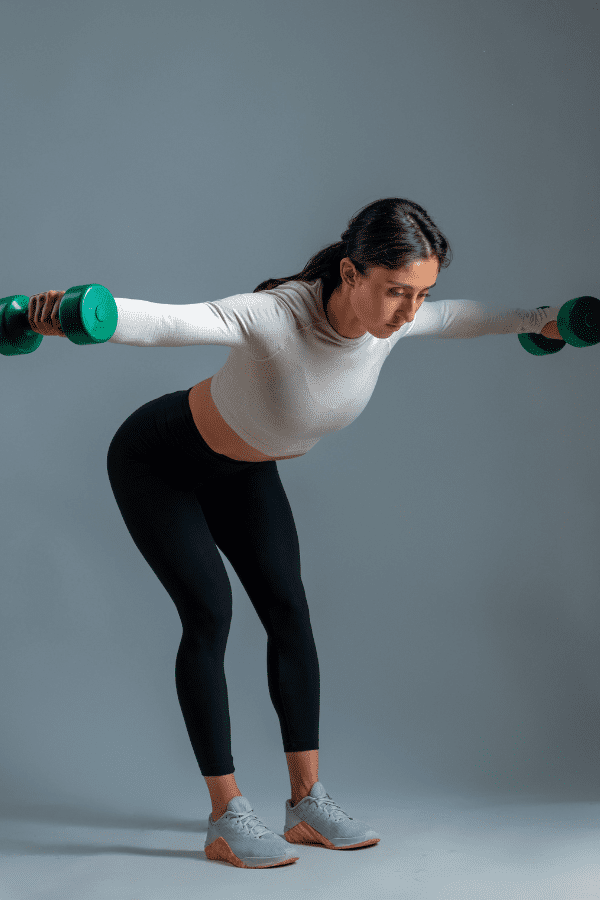
The Dumbbell Rear Delt Raise isolates the posterior deltoids and mimics the motion of the reverse pec deck fly, making it an excellent substitute if you have dumbbells to work with.
Step-by-Step Instruction
- Grab your dumbbells (or plates) and bend at the waist until you are close to perpendicular to the floor.
- I recommend slightly bending the elbow and keeping your palms facing each other. As you execute the movement, the palms will face the floor.
- Initiate the movement by bringing your arms out to the side and squeezing the shoulder blades.
- Pause at the top of the movement for about 1 second.
- Slowly lower your arms back to the starting position.
Coaching Points
In the setup, be sure to bend at the waist enough so that you are perpendicular as much as possible. In this movement, the burn should be felt in the upper back and rear shoulders. If your setup is too vertical, you may feel the burn in the traps or medial delts.
Don’t hitch (bounce) into lockout. If you find yourself using your torso to hitch, go down in weight. The emphasis here is on time under tension and quality movement still matters.
Band Face Pulls

Face Pulls target the posterior deltoids, rhomboids, and traps, similar to the muscle engagement in Reverse Pec Deck Flys.
FYI: Face Pulls can be done with a Resistance Band or Cable Machine. Both work great depending on what equipment you have access to.
Step-by-Step Instructions
- Loop a resistance band around the vertical beam of a squat rack at shoulder height.
- Grab the band with an overhand grip, hands roughly 3 inches apart.
- Stand far enough away from the rack to get tension on the band.
- Set feet shoulder-width apart, stand tall and brace the core.
- Pull the band directly towards the chin.
- Control the band back to the starting position and repeat.
Coaching Points
The key to Band Face Pulls is figuring out the proper distance away from the rack to stand. This will depend upon your strength and the strength of the band you are using. You want to be far enough away from the rack to create good resistance, but not so far that you can’t complete the reps with good form.
Don’t rush. This is an exercise that it’s easy to speed through it and just go through the motions. Focus on each rep and the contraction at the top of the rep.
Resistance Band Pull Apart

Band Pull Aparts use the same motion as the pec deck fly, but with a resistance band, which provides continuous tension, aiding muscle growth and endurance.
Step-by-Step Instructions
- Grab a resistance band, one hand on each end of the band.
- Hold the band out in the front of the chest.
- Now pull back and directly out to the side, as if you are trying to ‘tear’ the band in half.
- Pull back until the band hits the chest.
- Let the band retrace back to the starting position under control.
- Repeat for the designated number of reps.
Coaching Points
The biggest key to Band Tears is choosing the proper band. Too thick of a band will make the movement almost impossible to do with proper form and too thin of a band won’t give enough resistance.
Barbell Upright Row
Upright Rows may not look like a reverse fly, but they do work similar muscle groups – namely the posterior deltoids and traps.
Step-by-Step Instructions
- Starting position is with your feet shoulder-width apart, slight bend in the knee.
- Grasp bar about shoulder-width apart.
- Hold the barbell with an overhand (pronated) grip.
- Start with the bar at arm’s length.
- Pull the bar upward along the abdomen and chest toward the chin.
- At the top, the elbow should be higher than the wrist, and above the shoulders.
- Lower the bar slowly and under control to the front of the thighs.
- Do not jerk.
- Keep the bar close to the torso.
Coaching Points
The biggest mistake I see, by far, with Upright Rows is swinging way too much to lift the bar. A little swing is okay if you’re trying to grind out the last rep or two of a set.
However, if you’re having to rock your torso for every rep then the weight is too heavy. Take some weight off the bar and use proper form.
TRX Rear Delt Fly
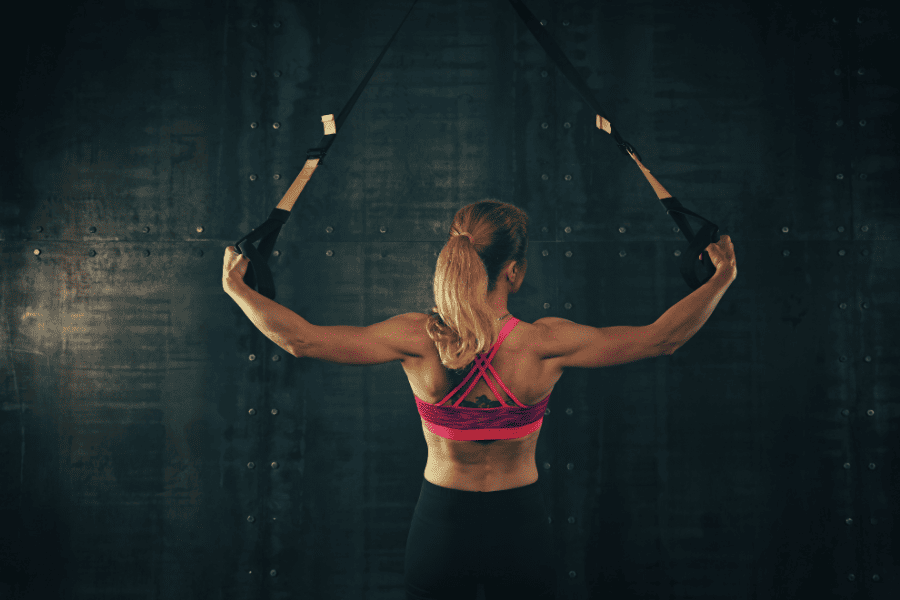
A great option for when traveling with your TRX strap, TRX Rear Delt Flys are another great posterior delt exercise like Reverse Pec Deck Flys.
Step-by-Step Instructions
- Begin by adjusting the TRX straps to mid-length. Stand facing the anchor point, hold a handle in each hand with your palms facing each other. Lean back slightly, extending your arms fully in front of you at shoulder height.
- Make sure your feet are hip-width apart, with your weight primarily on your heels. This is your starting position.
- Brace your abdominal muscles as you prepare to start the movement. This will help maintain your balance and protect your lower back throughout the exercise.
- Keeping your body straight and your arms fully extended, slowly spread your arms apart in a ‘T’ shape. Remember to keep your wrists firm and straight.
- As your arms reach their maximum spread, squeeze your shoulder blades together. You should feel a strong contraction in your rear deltoids and upper back.
- Slowly reverse the movement, controlling the return with your rear delts and upper back muscles rather than allowing the straps to yank your arms back. This ensures that your muscles, not momentum, are doing the work.
Coaching Points
The key to effective TRX exercises is control and stability. So keep your movements slow and your body stable.
One of the most important aspects of TRX exercises is maintaining correct body alignment. Keep your body straight from head to heels throughout the movement. Any bending or sagging in the middle can lead to less effective muscle engagement and potential injury.
Reverse Cable Crossover
Working out in a hotel gym and don’t have much to work with other than a universal cable machine?
Reverse Cable Crossovers may be just the answer you’re looking for.
Step-by-Step Instructions
- Start by setting up the cable machine: Position the pulleys at shoulder height or slightly below and attach a single handle to each side.
- Stand in the center of the cable machine with your feet shoulder-width apart and a slight bend in your knees. Grab a handle in each hand with an overhand grip.
- Take a step forward with one foot to create a stable base. This will help maintain balance and control throughout the exercise.
- Extend your arms out to the sides, keeping them slightly bent. Your palms should be facing forward, and your elbows should be slightly below shoulder level. This is your starting position.
- Engage your core muscles and maintain an upright posture throughout the exercise.
- Keeping your arms slightly bent, exhale and pull the handles in front of your body, crossing them over each other. Focus on squeezing your chest muscles as you bring your hands together.
- Pause briefly at the fully contracted position, feeling the tension in your chest and shoulders.
- Inhale and slowly return your arms back to the starting position in a controlled manner.
- Repeat the movement for the desired number of repetitions.
Coaching Points
Avoid using excessive momentum or swinging your body during the exercise. Focus on controlled movements to fully engage your muscles.
Keep your shoulders relaxed and down, avoiding any shrugging or tension.
Chest Supported Rows
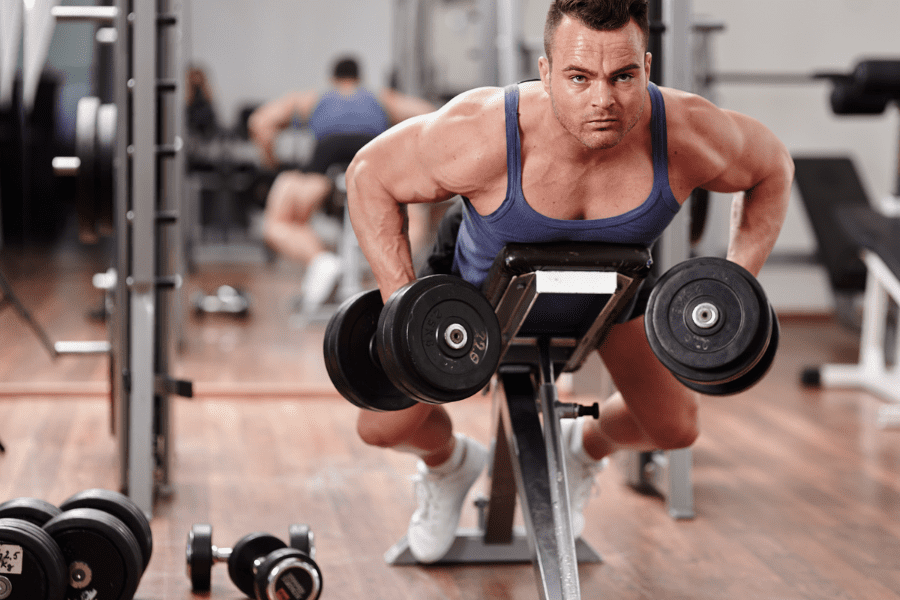
Chest Supported Rows will not target the posterior delts the same way most of the other exercises on this list will (although you could do chest-supported rear delt raises if you wanted to) because some of the bigger muscle groups will get engaged with these rows.
However, they’re still a great mid and even upper-back developer that can add some variety to your rowing workouts.
How To
- Set up an adjustable bench at a 45-degree angle.
- Lay on your stomach with your head hanging just above the edge of the bench.
- Grab a dumbbell in each hand and set up with a good posture – core and lats engaged and shoulders neutral.
- Row the dumbbells toward the top of the stomach and squeeze the back at the top of the rep.
- Finally, lower the dumbbells back to the starting position and repeat until all reps are completed.
Coaching Points
Make sure to maintain good posture through the movement. Oftentimes I see athletes who allow their shoulders to slouch forward and drape over the edges of the bench.
Scap Pushups
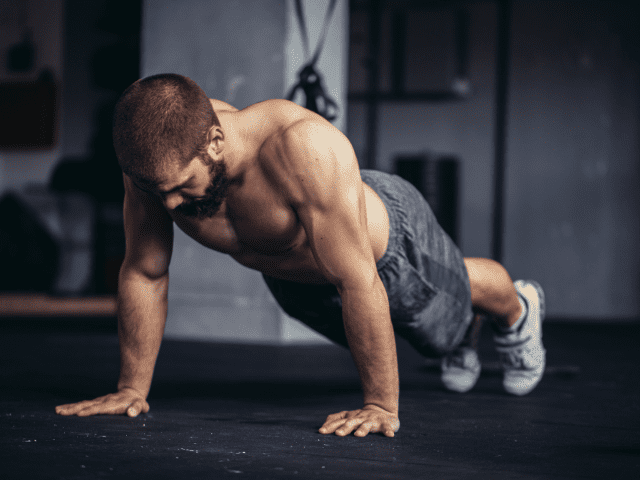
Scap Pushups are a simple, but effective movement for the upper back that I love to work into warmups because they’re quick to do and don’t require any equipment.
Step-by-Step Instructions
- Scap Pushups begin with the athlete in a push-up position.
- Hands should be directly under the shoulders. The body should be in a straight line, core engaged.
- Retract the shoulder blades by actively lowering the chest and allowing the shoulder blades to slide together.
- Now protract the shoulder blades by elevating the chest, essentially trying to ‘reach’ the upper torso toward the sky.
- Arms should stay straight throughout the movement.
Coaching Points
Do NOT rush through this movement. Yes, the longer you hold the position the more challenging it is on not only your shoulders, but your core as well. This is part of the point of the exercise is to continue forcing the body to stabilize once fatigue starts to set in. Embrace that aspect of the movement.
Keep arms straight! Easily the biggest mistake I see with athletes with Scap Pushups is wanting to bend the arms on the scap retraction. Keep the arms straight and focus on the movement of the shoulder blades.
A, Y, T
A, Y, Ts are a combo of three exercises that really target the muscles of the rotator cuff. They are a great option either as part of a warm-up or towards the end of a workout.
How To
- Adjust a bench up to about 30 degrees and grab two light weight plates.
- Lay on your stomach with your head hanging off the top of the bench.
- Set up in the starting position by engaging the lats and pulling the shoulder blades together.
- Now, keep the arms straight and raise the plates overhead (like the A in YMCA).
- Lower back down under control and complete 10 reps.
- Once all reps are done immediately begin doing Ys by raising the plates at a 45-degree angle, thumbs pointed toward the ceiling.
- Once you’ve completed ten Ys, finish with 10 Ts.
- Ts are done by raising the arms straight to the side, thumbs still pointing up.
Coaching Points
Keep the shoulder blades pulled back, but do not shrug up. Shrugging up takes the emphasis away from the focus of A, Y, Ts.
Stay in control of each rep. Do not allow weights to be swung up and down.
Dumbbell Single-Arm Snatch
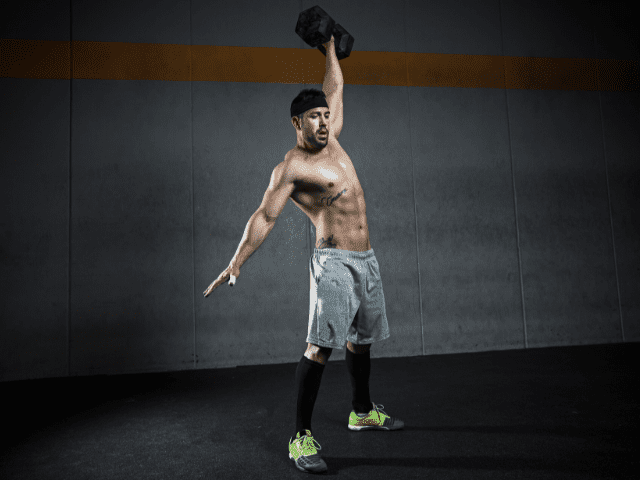
Single Arm Snatches don’t look anything like the other exercises listed above, but sometimes that’s a good thing.
Dumbbell Snatches are a dynamic movement that is an excellent power developer, but the posterior delts and upper back are also heavily involved in the movement.
So, if you want something a little different that will also hit those areas, consider adding this Olympic lift variation into your program.
Step-by-Step Instructions
- Grab a dumbbell and stand with feet about shoulder-width apart.
- Put a slight bend in the knee, brace the core and set the back – shoulder blades pulled back, lats engaged, chest out.
- Hinge forward by pushing the hips back and let the dumbbell slide down right in between the knees, coming at a stop just below the knee.
- You are now in the ‘power position’.
- From here, drive the feet through the floor and aggressively extend the hips, driving the shoulders up and slightly back.
- As you reach triple extension of the hips, knees and ankles – use a quick, powerful shrug and allow the elbow to break and begin the pull with the arm.
- Keep the dumbbell close to the body as it travels up.
- Once the dumbbell reaches the highest point of the pull, rotate at the elbow to catch the dumbbell overhead while simultaneously dropping the hips into a quarter squat and shift the feet slightly out.
- Finish the rep by standing tall and lowering the dumbbell down to the shoulder first and then back to the starting position under control.
- Repeat until all reps are completed and then switch arms.
Coaching Points
The dumbbell should travel close to the body all the up until it gets about head height, then rotate the elbow, drop the hips and catch. Don’t allow it to swing forward out away from the body.
The second technique flaw is not staying braced through the return of the dumbbell to the starting position, oftentimes from being in too big of a hurry to knock out reps. Letting the dumbbell, especially the heavier you get, yank the shoulder down at the bottom of the rep is asking for trouble.

Online Strength Programs
- 1-on-1 Online Coaching
- Sports Performance Programs for Football, Basketball, Soccer & More
- Programs for Former Athletes (Legends) Who Still Want to Train Like Athletes
- Programs for Adults Who Want to Get Healthy (and look great at the beach!)
- Use Code “HB10” to Get 10% Off Today
Final Thoughts
Reverse Pec Deck Flys are an excellent exercise for training the rear deltoids.
However, if you don’t have a Pec Deck machine, then you’re going to need an alternative for them. Or, even if you do have a Pec Deck machine, you should always be periodically changing up your routine to keep things fresh.
In either case, I hope the list of alternative exercises has given you at least one good option that fits your need and your available equipment.
